Dual Band Antenna Design and Prediction of Resonance Frequency Using Machine Learning Approaches
Abstract
1. Introduction
- i
- Simulate and analyze the performance of a microstrip patch antenna using CST EM simulation tools.
- ii
- Validate the CST simulation results using ADS simulation software, and the simulated S11 is compared with the measured S11.
- iii
- The resonance frequency () is predicted using six ML regression algorithms and CNN. A comparative study of the different models based on the different predicted results is incorporated.
2. Design Methodology
3. Result Analysis of the Proposed MPA
3.1. Simulated and Measured Results
3.2. RLC Lumped Element Extraction and Equivalent Circuit of the Proposed MPA Using ADS
3.3. Machine Learning-Based Resonance Frequency Prediction
4. Brief Description of the Learning Models
Performance Evaluation of the ML Models
5. Conclusions
Author Contributions
Funding
Institutional Review Board Statement
Informed Consent Statement
Data Availability Statement
Acknowledgments
Conflicts of Interest
References
- Paul, L.C.; Ali, H.; Sarker, N.; Mahmud, Z.; Azim, R.; Islam, M.T. A Wideband Rectangular Microstrip Patch Antenna with Partial Ground Plane for 5G Applications. In Proceedings of the 2021 Joint 10th International Conference on Informatics, Electronics & Vision (ICIEV) and 2021 5th International Conference on Imaging, Vision & Pattern Recognition (icIVPR), Kitakyushu, Japan, 16–20 August 2021. [Google Scholar]
- Kannadhasan, S.; Nagarajan, R. Performance Improvement of S-shaped for Wireless Communication. In Electronic Systems and Intelligent Computing; Springer: Singapore, 2022; pp. 15–22. [Google Scholar]
- Chowdhury, S.G.; Arefin, M.S.; Faisal, M.M.A. Design Simulation and Analysis of a Dual Band Microstrip Patch Antenna for GPS and WLAN Applications. 2021. Available online: http://dspace.iiuc.ac.bd:8080/xmlui/handle/123456789/3105 (accessed on 10 August 2022).
- Le, D.; Ahmed, S.; Ukkonen, L.; Björninen, T. A Small All-Corners-Truncated Circularly Polarized Microstrip Patch Antenna on Textile Substrate for Wearable Passive UHF RFID Tags. IEEE J. Radio Freq. Identif. 2021, 5, 106–112. [Google Scholar] [CrossRef]
- Paul, L.C.; Sarkar, A.K.; Haque, A.; Miah, P.; Ghosh, P.M.; Islam, R. Investigation of the dependency of an inset feed rectangular patch antenna parameters with the variation of notch width for WiMax applications. In Proceedings of the 2018 Second International Conference on Electronics, Communication and Aerospace Technology (ICECA), Coimbatore, India, 29–31 March 2018. [Google Scholar]
- Huang, G.S.; Li, S.J.; Li, Z.Y.; Liu, X.B.; Di, L.R.J.; Cao, X.Y. Coding-Feeding Metasurface for Diffusion and Dual-Band Emission. Adv. Theory Simul. 2022, 5, 2200006. [Google Scholar] [CrossRef]
- Shi, C.; Zou, J.; Gao, J.; Liu, C. Gain Enhancement of a Dual-Band Antenna with the FSS. Electronics 2022, 11, 2882. [Google Scholar] [CrossRef]
- Muntoni, G.; Montisci, G.; Casula, G.A.; Chietera, F.P.; Michel, A.; Colella, R.; Catarinucci, L.; Mazzarella, G. A curved 3-D printed microstrip patch antenna layout for bandwidth enhancement and size reduction. IEEE Antennas Wirel. Propag. Lett. 2020, 19, 1118–1122. [Google Scholar] [CrossRef]
- Bansal, A.; Gupta, R. A review on microstrip patch antenna and feeding techniques. Int. J. Inf. Technol. 2020, 12, 149–154. [Google Scholar] [CrossRef]
- Fouany, J.; Thevenot, M.; Arnaud, E.; Torres, F.; Menudier, C.; Monediere, T.; Elis, K. New concept of telemetry X-band circularly polarized antenna payload for cubesat. IEEE Antennas Wirel. Propag. Lett. 2017, 16, 2987–2991. [Google Scholar] [CrossRef]
- Khac, K.N.; Phong, N.D.; Manh, L.H.; Le Trong, T.A.; Le Huu, H.; Hien, B.T.T.; Chien, D.N. A design of circularly polarized array antenna for X-band cubesat satellite communication. In Proceedings of the 2018 International Conference on Advanced Technologies for Communications (ATC), Ho Chi Minh City, Vietnam, 18–20 October 2018; pp. 53–56. [Google Scholar]
- Ganaraj, G.; Kumar, C.; Kumar, V.S. High gain circularly polarized resonance cavity antenna at X-band. In Proceedings of the 2017 IEEE International Conference on Antenna Innovations & Modern Technologies for Ground, Aircraft and Satellite Applications (iAIM), Bangalore, India, 24–26 November 2017; pp. 1–5. [Google Scholar]
- Trentini, G.V. Partially reflecting sheet arrays. IRE Trans. Antennas Propag. 1956, AP-4, 666–671. [Google Scholar] [CrossRef]
- Asaadi, M.; Sebak, A. Gain and bandwidth enhancement of 2 × 2 square dense dielectric patch antenna arrays using a Holey superstrate. IEEE Antennas Wirel. Propag. Lett. 2017, 16, 1808–1811. [Google Scholar]
- Razi, Z.M.; Rezaei, P. Fabry–Perot cavity antenna based on capacitive loaded strips superstrate for X-band satellite communication. Adv. Radar Syst. J. 2013, 2, 26–30. [Google Scholar]
- Gupta, R.; Mukherjee, J. Effect of superstrate material on a high-gain antenna using array of parasitic patches. Microw. Opt. Technol. Lett. 2010, 52, 82–88. [Google Scholar] [CrossRef]
- Orr, R.; Goussetis, G.; Fusco, V. Design method for circularly polarized Fabry–Perot cavity antennas. IEEE Trans. Antennas Propag. 2014, 62, 19–26. [Google Scholar] [CrossRef]
- Rahman, M.N.; Islam, M.T.; Misran, N.; Samsuzzaman, M. A tuning fork-shaped microstrip patch antenna for X-band satellite and radar applications. In Proceedings of the 2017 6th International Conference on Electrical Engineering and Informatics (ICEEI), Langkawi, Malaysia, 25–27 November 2017; pp. 1–2. [Google Scholar]
- Ogurtsov, S.; Koziel, S. A conformal circularly polarized series-fed microstrip antenna array design. IEEE Trans. Antennas Propag. 2019, 68, 873–881. [Google Scholar] [CrossRef]
- Alkaraki, S.; Gao, Y.; Stremsdoerfer, S.; Gayets, E.; Parini, C.G. 3D printed corrugated plate antennas with high aperture efficiency and high gain at X-band and Ka-band. IEEE Access 2020, 8, 30643–30654. [Google Scholar] [CrossRef]
- Ccoillo-Ramos, N.R.; Aboserwal, N.; Qamar, Z.; Salazar-Cerreno, J.L. Improved Analytical Model for a Proximity Coupled Microstrip Patch Antenna (PC-MSPA). IEEE Trans. Antennas Propag. 2021, 69, 6244–6252. [Google Scholar] [CrossRef]
- Kim, J.H.; Choi, S.W. A Deep Learning-Based Approach for Radiation Pattern Synthesis of an Array Antenna. IEEE Access 2020, 8, 226059–226063. [Google Scholar] [CrossRef]
- El Misilmani, H.M.; Naous, T.; Al Khatib, S.K. A review on the design and optimization of antennas using machine learning algorithms and techniques. Int. J. RF Microw. Comput.-Aided Eng. 2020, 30, e22356. [Google Scholar] [CrossRef]
- Bang, J.; Kim, J.H. Predicting Power Density of Array Antenna in mmWave Applications with Deep Learning. IEEE Access 2021, 9, 111030–111038. [Google Scholar] [CrossRef]
- Zheng, B.; Zhang, H. Deep Learning Based Multi-layer Metallic Metasurface Design. In Proceedings of the IEEE International Symposium on Antennas and Propagation, Montreal, QC, Canada, 5–10 July 2020; pp. 2049–2050. [Google Scholar]
- Misilmani, H.M.E.; Naous, T. Machine Learning in Antenna Design: An Overview on Machine Learning Concept and Algorithms. In Proceedings of the 2019 International Conference on High Performance Computing & Simulation (HPCS), Dublin, Ireland, 15–19 July 2019; pp. 600–607. [Google Scholar]
- Erricolo, D.; Chen, P.-Y.; Rozhkova, A.; Torabi, E.; Bagci, H.; Shamim, A.; Zhang, X. Machine Learning in Electromagnetics: A Review and Some Perspectives for Future Research. In Proceedings of the 2019 International Conference on Electromagnetics in Advanced Applications (ICEAA), Granada, Spain, 9–13 September 2019; pp. 1377–1380. [Google Scholar]
- Yao, H.M.; Li, M.; Jiang, L. Applying Deep Learning Approach to the Far-Field Subwavelength Imaging Based on Near-Field Resonant Metalens at Microwave Frequencies. IEEE Access 2019, 7, 63801–63808. [Google Scholar] [CrossRef]
- Wu, Q.; Cao, Y.; Wang, H.; Hong, W. Machine-learning-assisted optimization and its application to antenna designs: Opportunities and challenges. China Commun. 2020, 17, 152–164. [Google Scholar] [CrossRef]
- Kushwah, V.S.; Tomar, G.S. Design and analysis of microstrip patch antennas using artificial neural network. In Trends in Research on Microstrip Antennas; IntechOpen: London, UK, 2017; p. 55. [Google Scholar]
- Soni, M.; Sharma, K.; Pandey, G.P.; Gupta, S.K. Resonant Frequency Prediction of Patch Antenna in the Presence of Inserted Airgap Using Machine Learning. In Advances in Smart Communication and Imaging Systems; Springer: Singapore, 2021; pp. 353–361. [Google Scholar]
- Aoad, A. Design and manufacture of a multiband rectangular spiral-shaped microstrip antenna using EM-driven and machine learning. Elektron. Ir Elektrotechnika 2021, 27, 29–40. [Google Scholar] [CrossRef]
- Balanis, C.A. Antenna Theory: Analysis and Design; John Wiley & Sons: Hoboken, NJ, USA, 2015. [Google Scholar]
- Barthia, P.; Rao, K.V.S.; Tomar, R.S. Millimeter Wave Microstrip and Printed Circuit Antenna; Artech House: Boston, MA, USA, 1991. [Google Scholar]
- Pozar, D.M. Microwave Engineering; John Wiley & Sons: Hoboken, NJ, USA, 2011. [Google Scholar]
- Jernelv, L.; Hjelme, D.R.; Matsuura, Y.; Aksnes, A. Convolutional neural networks for classification and regression analysis of one-dimensional spectral data. arXiv 2020, arXiv:2005.07530. [Google Scholar]
- Kıymık, E.; Erçelebi, E. Metamaterial Design with Nested-CNN and Prediction Improvement with Imputation. Appl. Sci. 2022, 12, 3436. [Google Scholar] [CrossRef]
- Manasa, J.; Gupta, R.; Narahari, N.S. Machine learning based predicting house prices using regression techniques. In Proceedings of the 2020 2nd International Conference on Innovative Mechanisms for Industry Applications (ICIMIA), Bangalore, India, 5–7 March 2020. [Google Scholar]
- Singh, B.; Sihag, P.; Singh, K. Modelling of impact of water quality on infiltration rate of soil by random forest regression. Model. Earth Syst. Environ. 2017, 3, 999–1004. [Google Scholar] [CrossRef]
- Rathore, S.S.; Kumar, S. A decision tree regression-based approach for the number of software faults prediction. ACM SIGSOFT Softw. Eng. Notes 2016, 41, 1–6. [Google Scholar] [CrossRef]
- Madhuri, C.H.R.; Anuradha, G.; Pujitha, M.V. House price prediction using regression techniques: A comparative study. In Proceedings of the 2019 International Conference on Smart Structures and Systems (ICSSS), Chennai, India, 14–15 March 2019. [Google Scholar]
- Israni, D.; Masalia, K.; Khasgiwal, T.; Tolani, M.; Edinburgh, M. Crop-yield prediction and crop recommendation system. SSRN Electron. J. 2022. [Google Scholar] [CrossRef]
- Torres-Barrán, A.; Alonso, Á.; Dorronsoro, J.R. Regression tree ensembles for wind energy and solar radiation prediction. Neurocomputing 2019, 326–327, 151–160. [Google Scholar] [CrossRef]
- Kumar, R.; Kumar, P.; Kumar, Y. Time series data prediction using IOT and machine learning technique. Procedia Comput. Sci. 2020, 167, 373–381. [Google Scholar] [CrossRef]
- Choo, J.; Pho TH, A.; Kim, Y.H. Machine Learning Technique to Improve an Impedance Matching Characteristic of a Bent Monopole Antenna. Appl. Sci. 2021, 11, 10829. [Google Scholar] [CrossRef]
- Harimurti, R.; Yamasari, Y.; Ekohariadi; Munoto; Asto, B.I.G.P. Predicting student’s psychomotor domain on the vocational senior high school using linear regression. In Proceedings of the 2018 International Conference on Information and Communications Technology (ICOIACT), Yogyakarta, Indonesia, 6–7 March 2018. [Google Scholar]
- Chai, T.; Draxler, R.R. Root means square error (RMSE) or mean absolute error (MAE)? Arguments against avoiding RMSE in the literature. Geosci. Model Dev. 2014, 7, 1247–1250. [Google Scholar] [CrossRef]
- Willmott, C.J.; Matsuura, K. Advantages of the mean absolute error (MAE) over the root mean square error (RMSE) in assessing average model performance. Clim. Res. 2005, 30, 79–82. [Google Scholar] [CrossRef]
- Weiming, J.M. Mastering Python for Finance—Second Edition. O’Reilly Online Learning. Available online: https://www.oreilly.com/library/view/mastering-python-for/9781789346466/d1ac368a-6890-45eb-b39c-2fa97d23d640.xhtml (accessed on 21 August 2022).
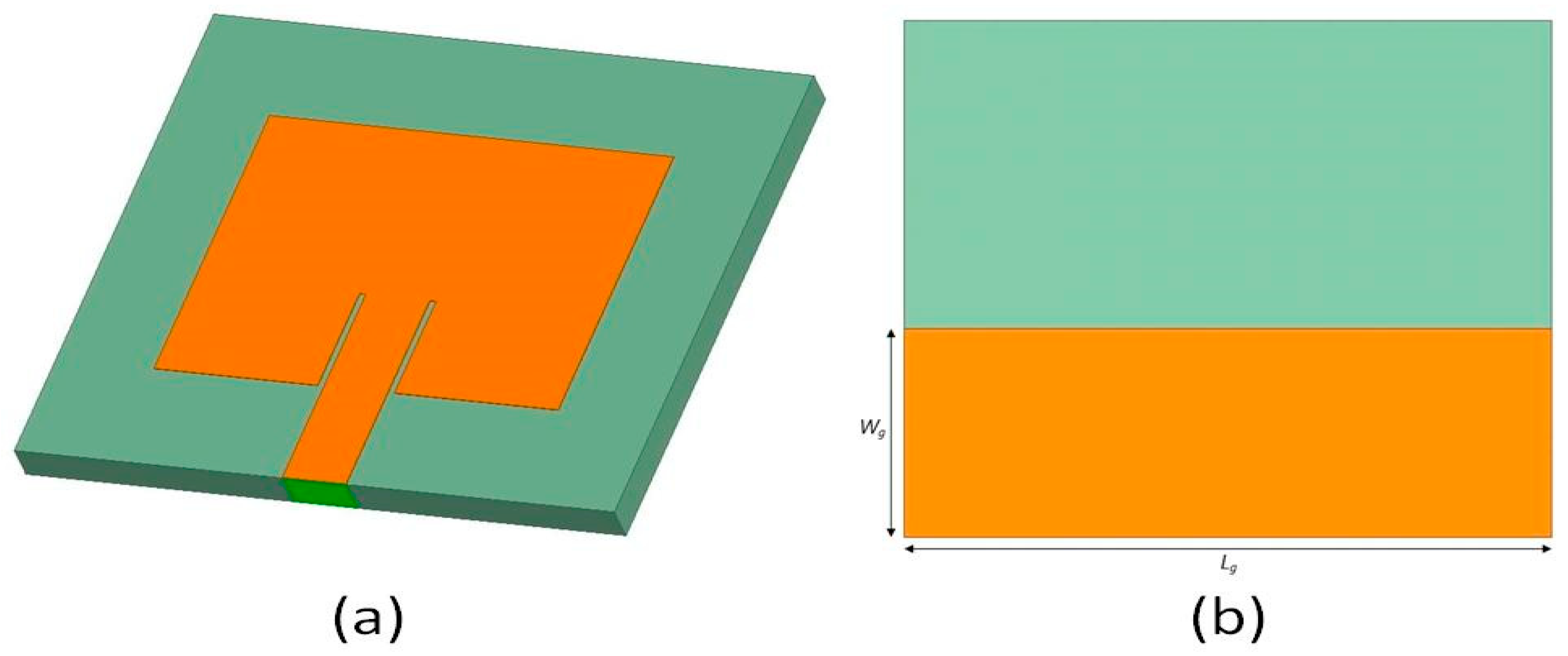
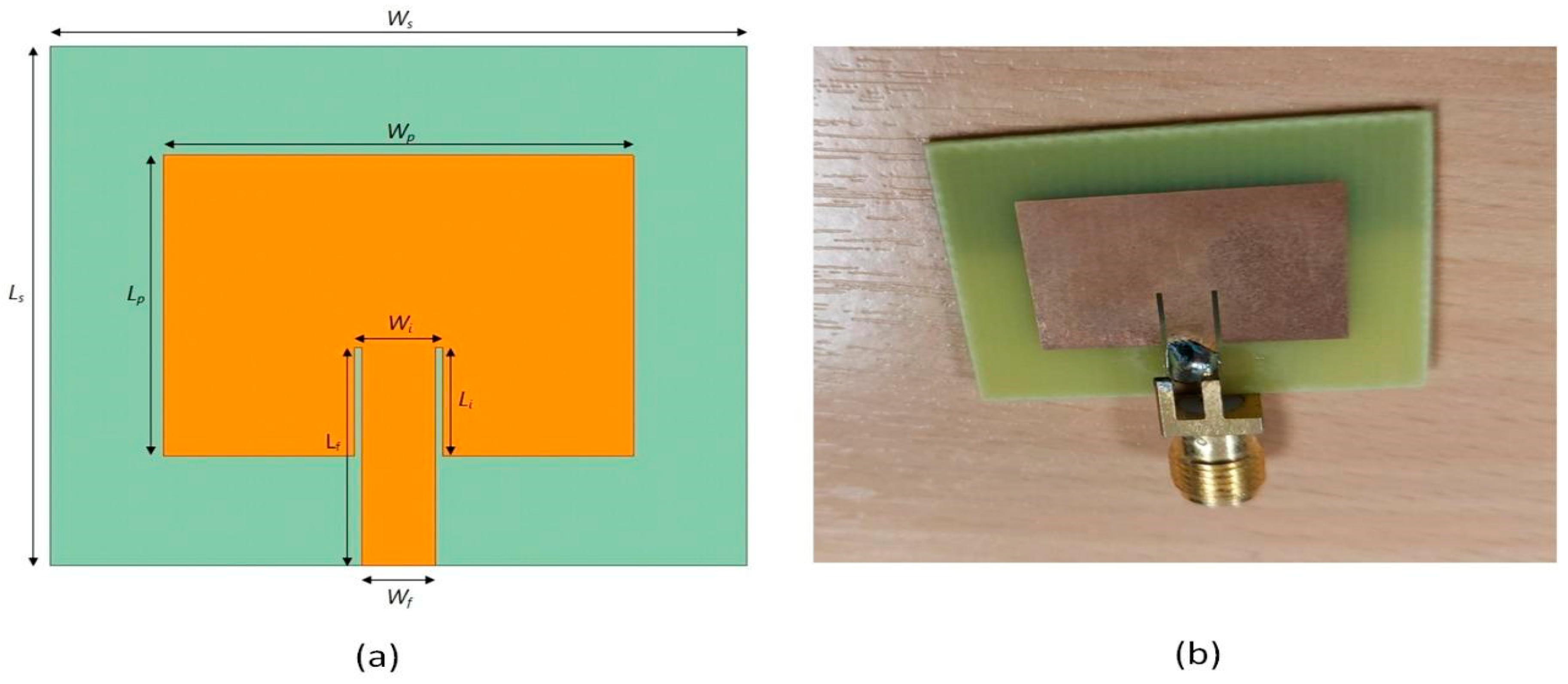
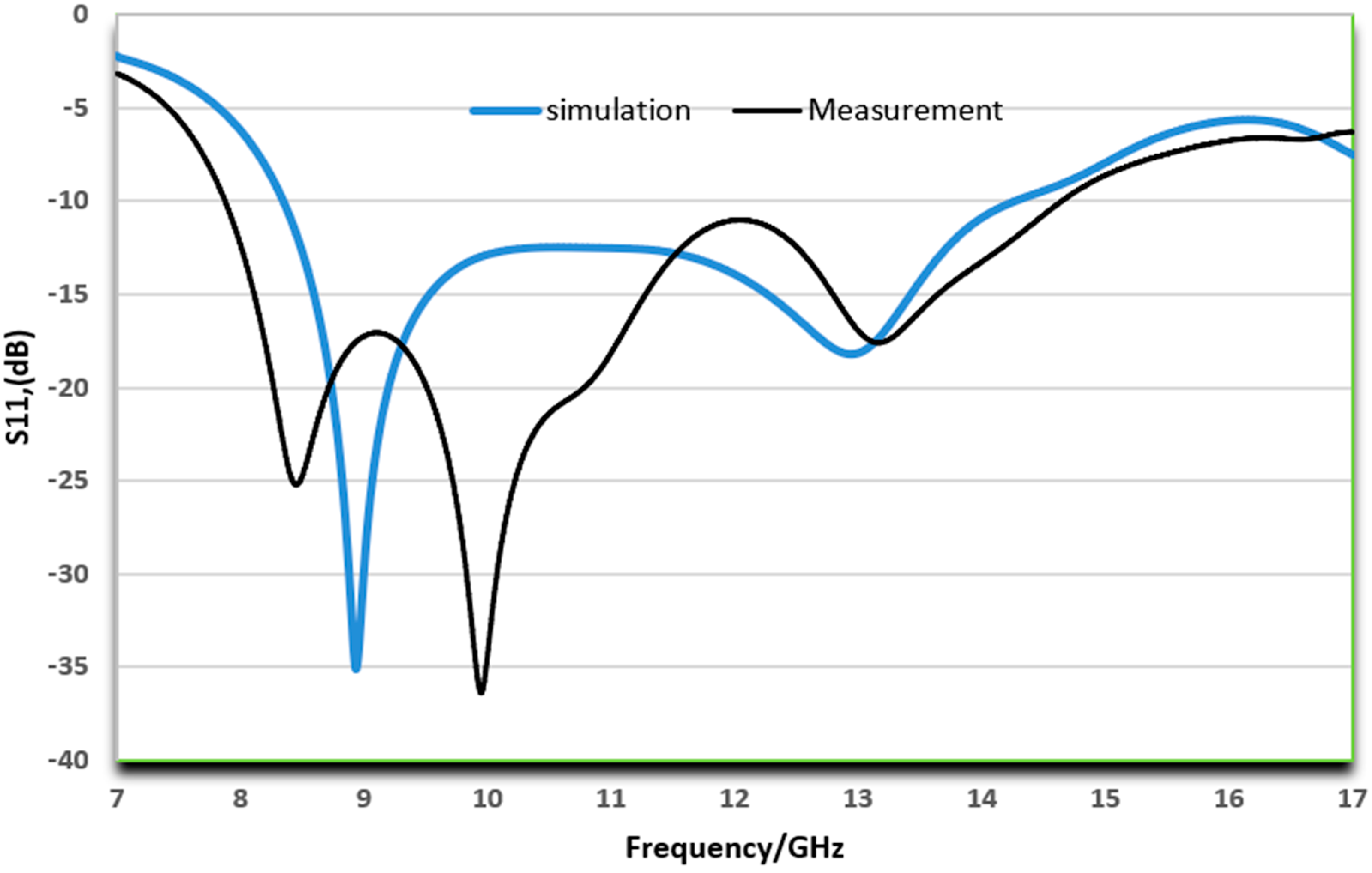
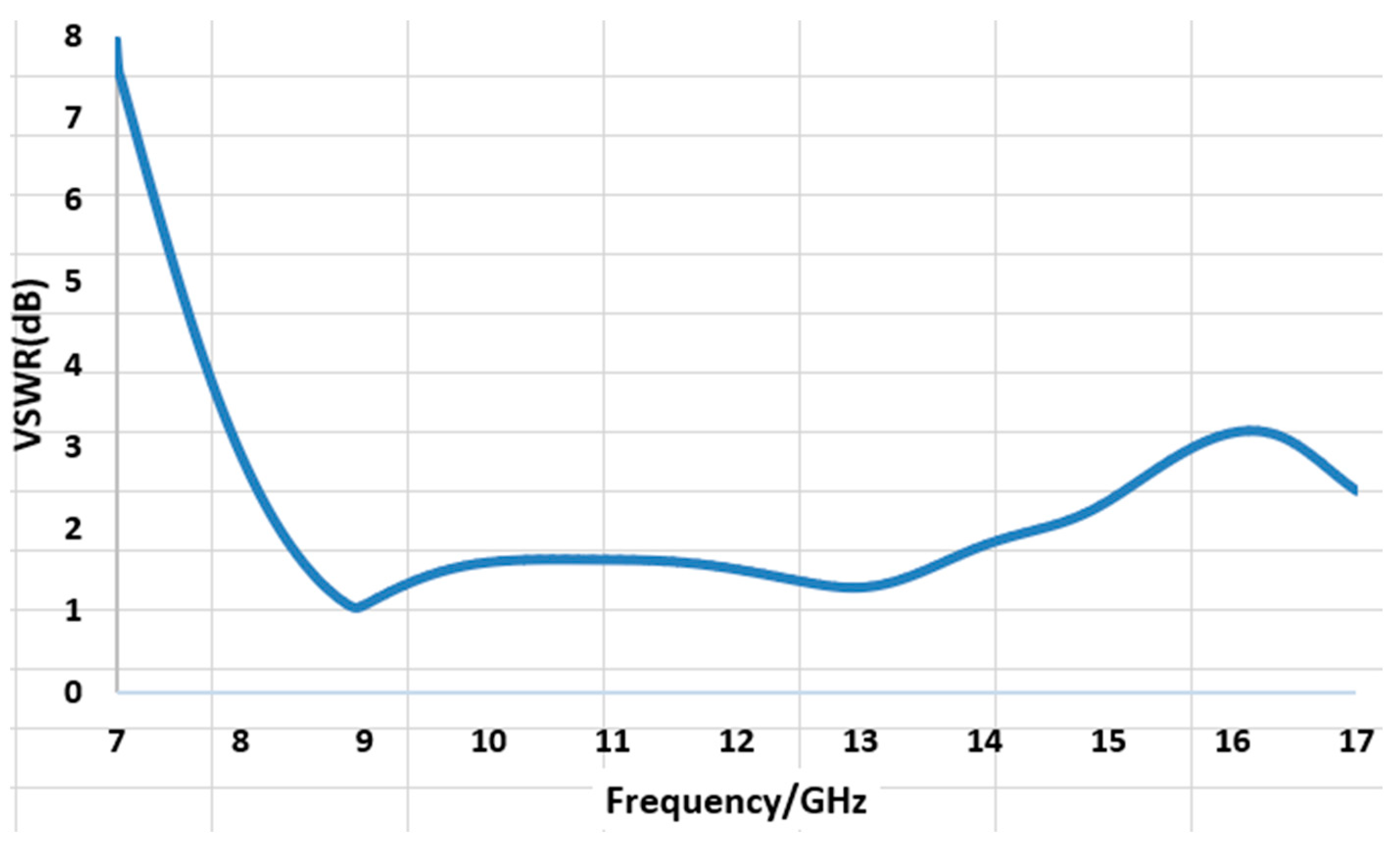
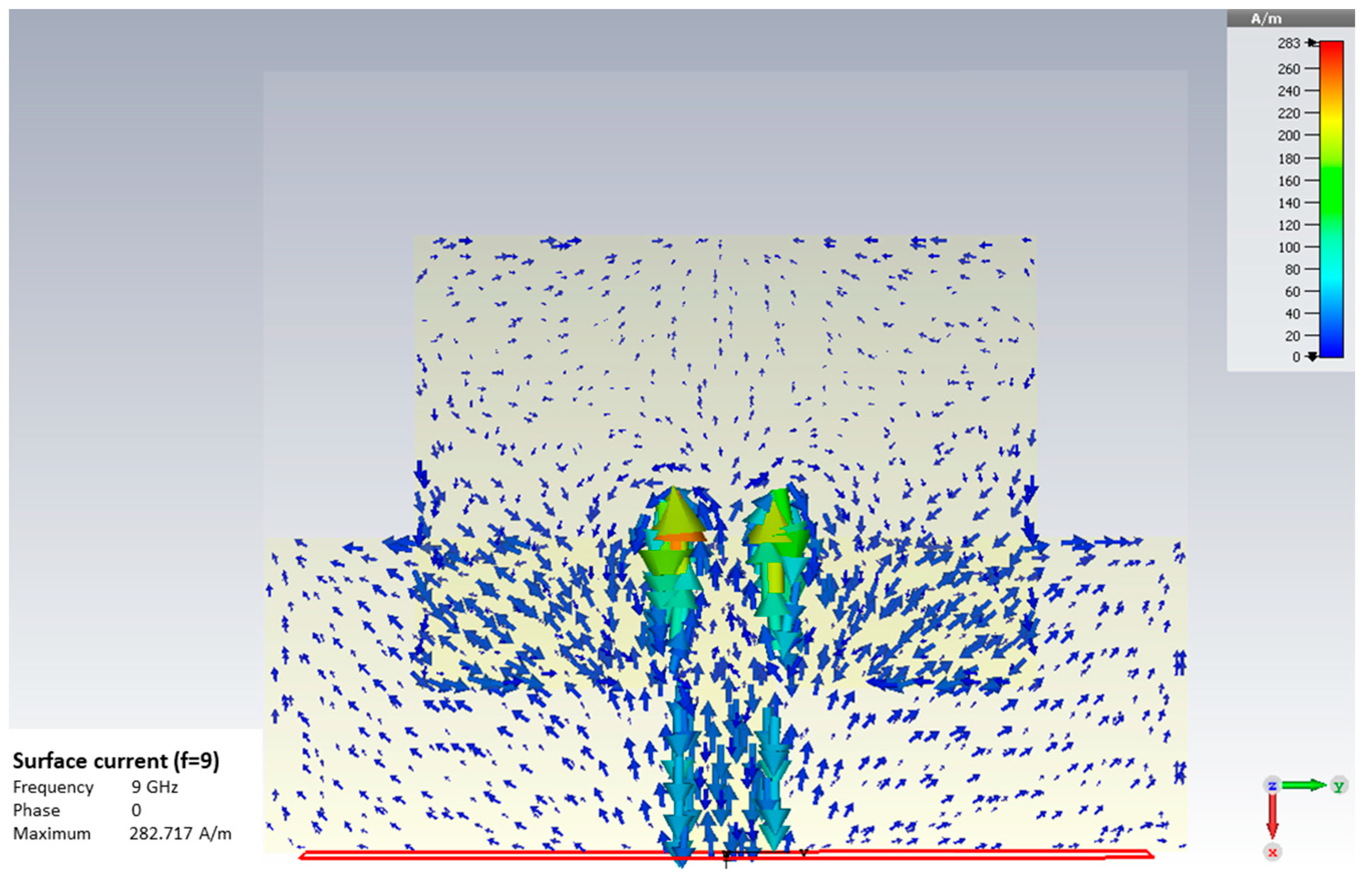


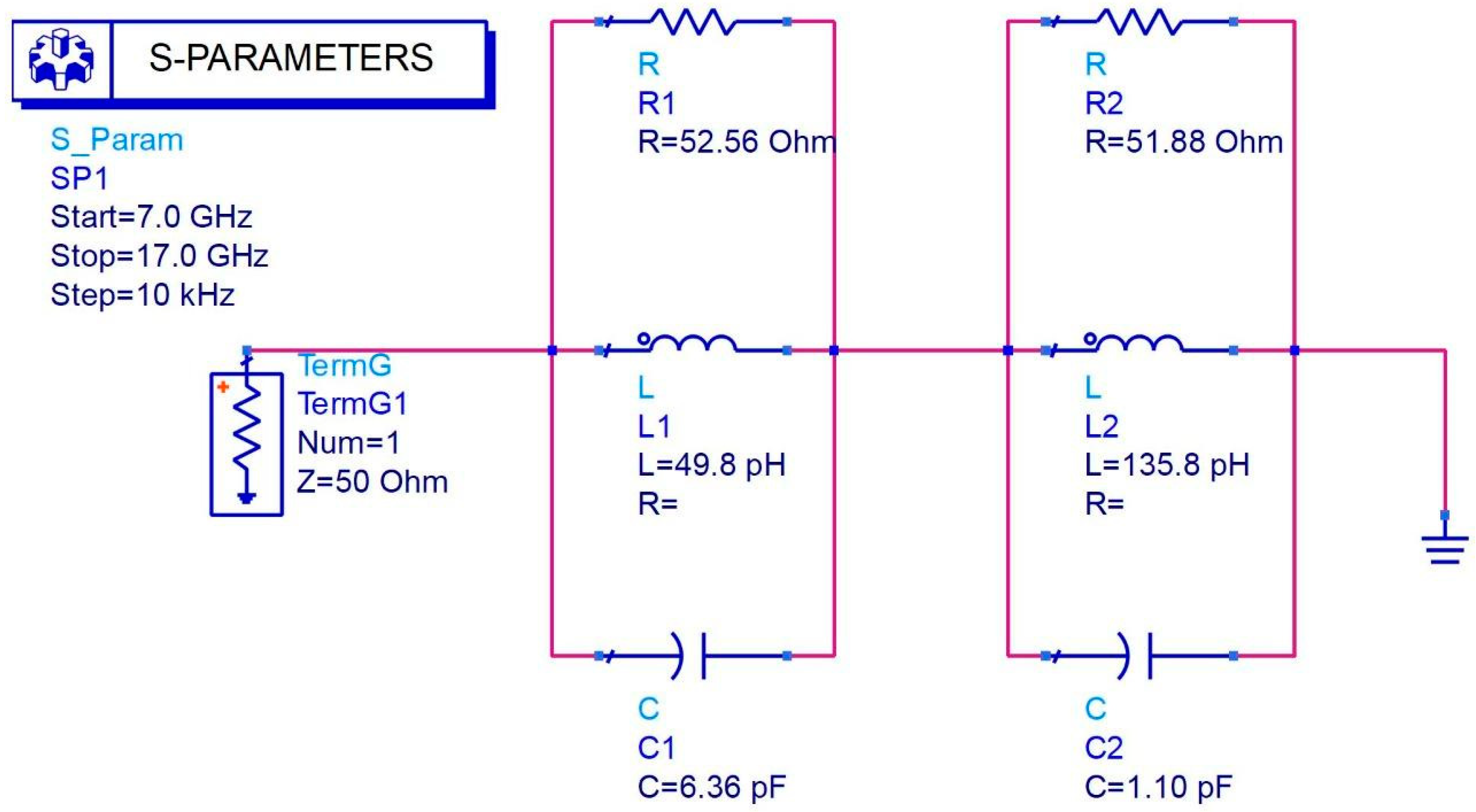
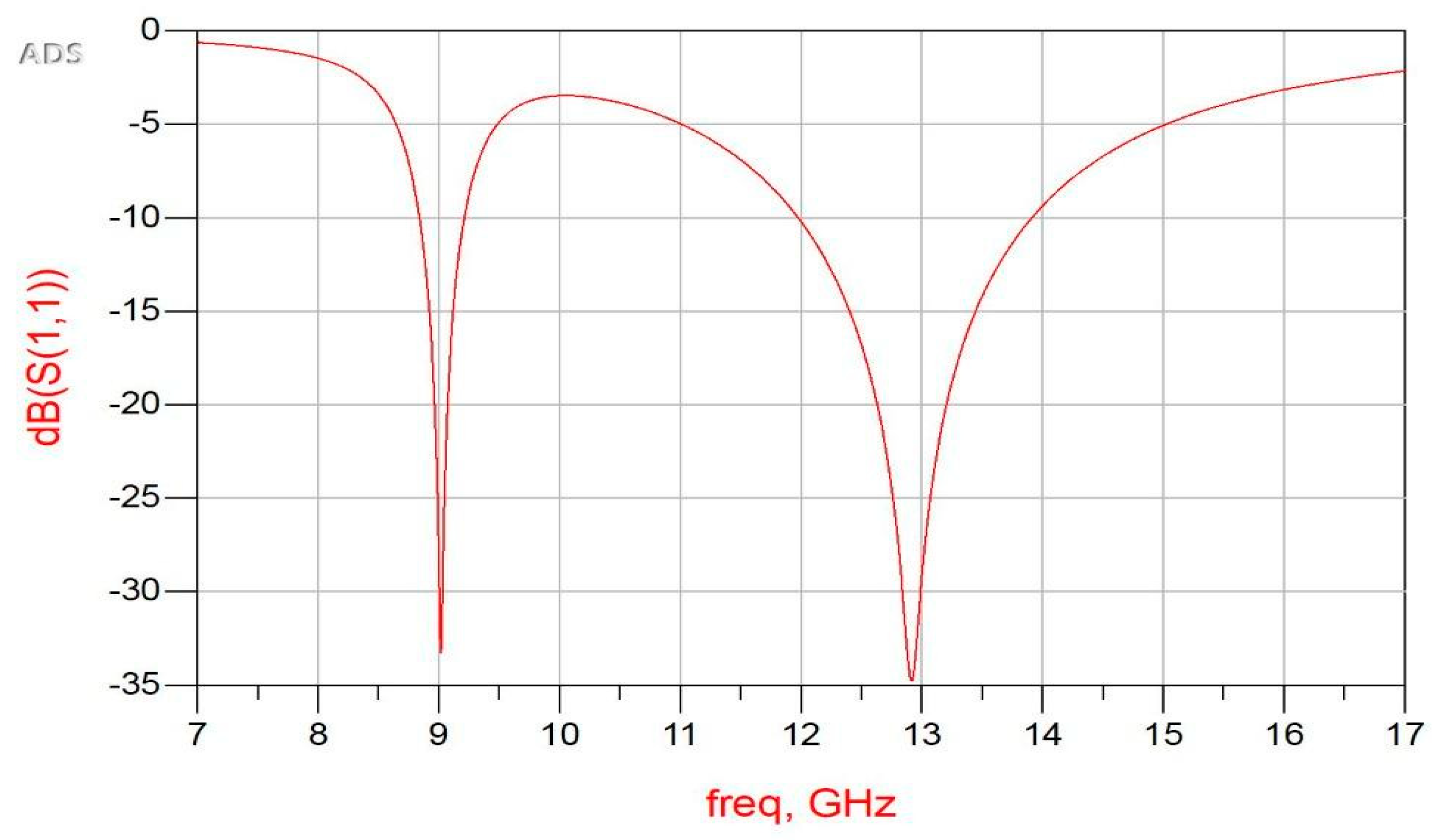


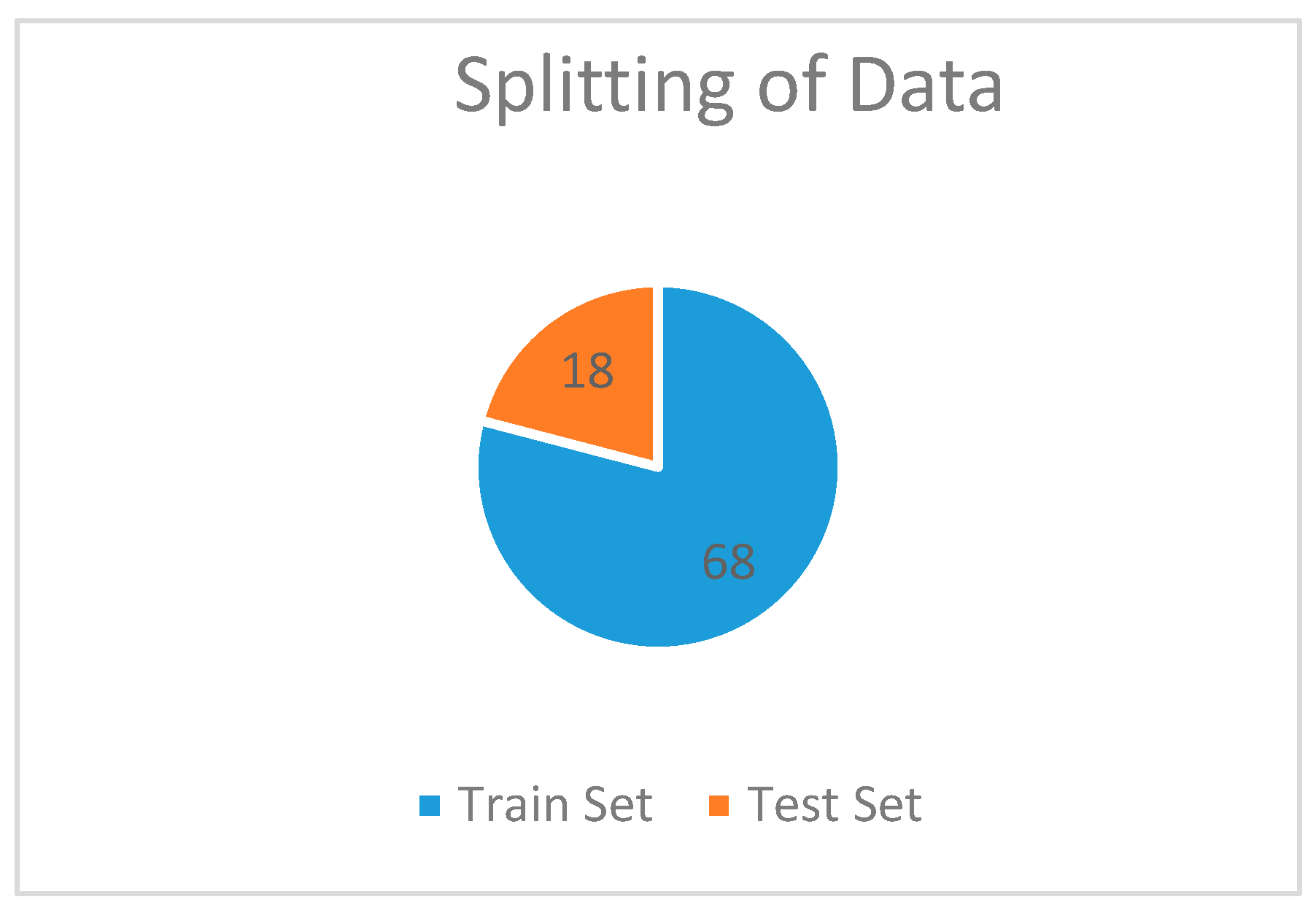
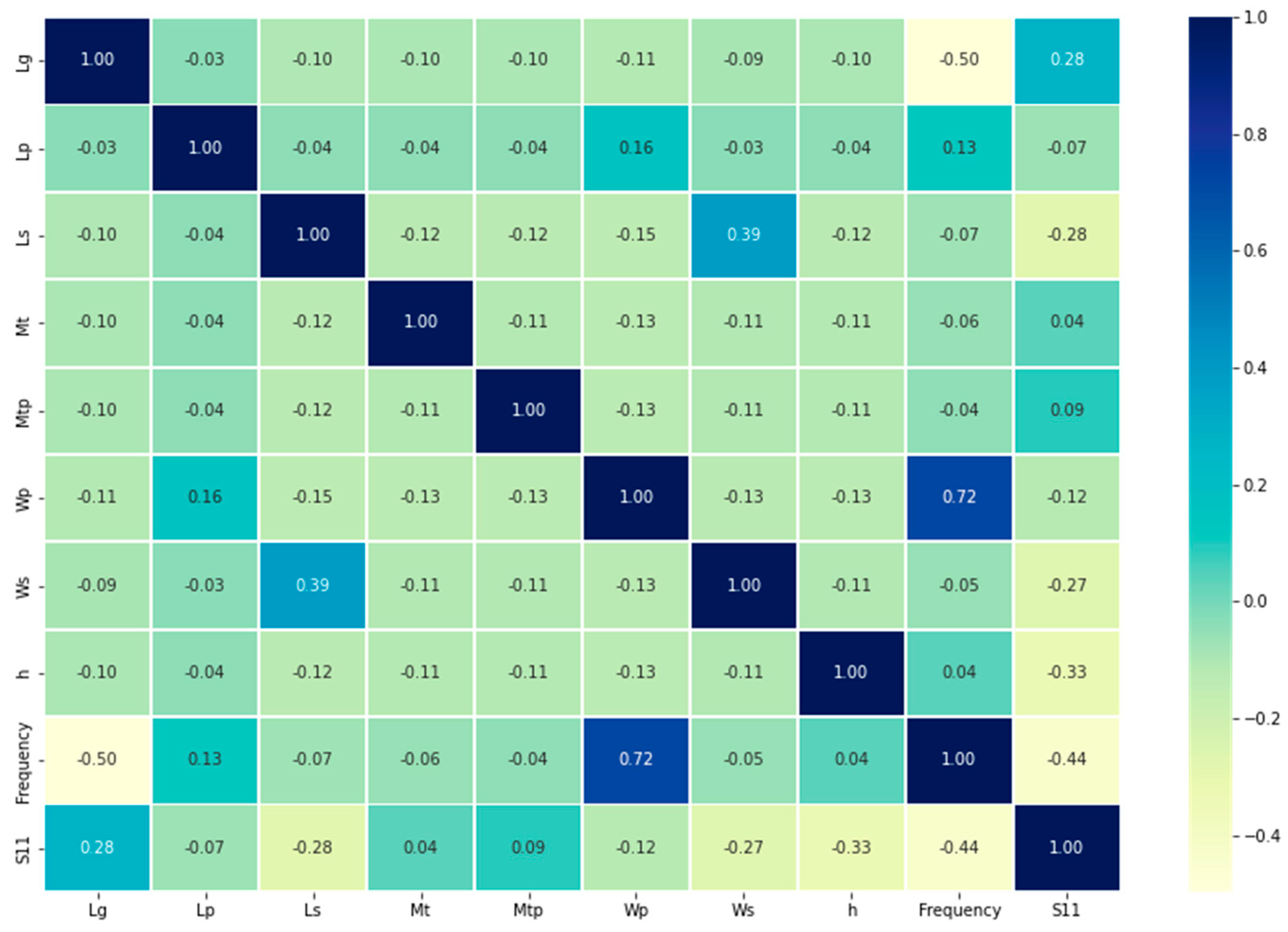
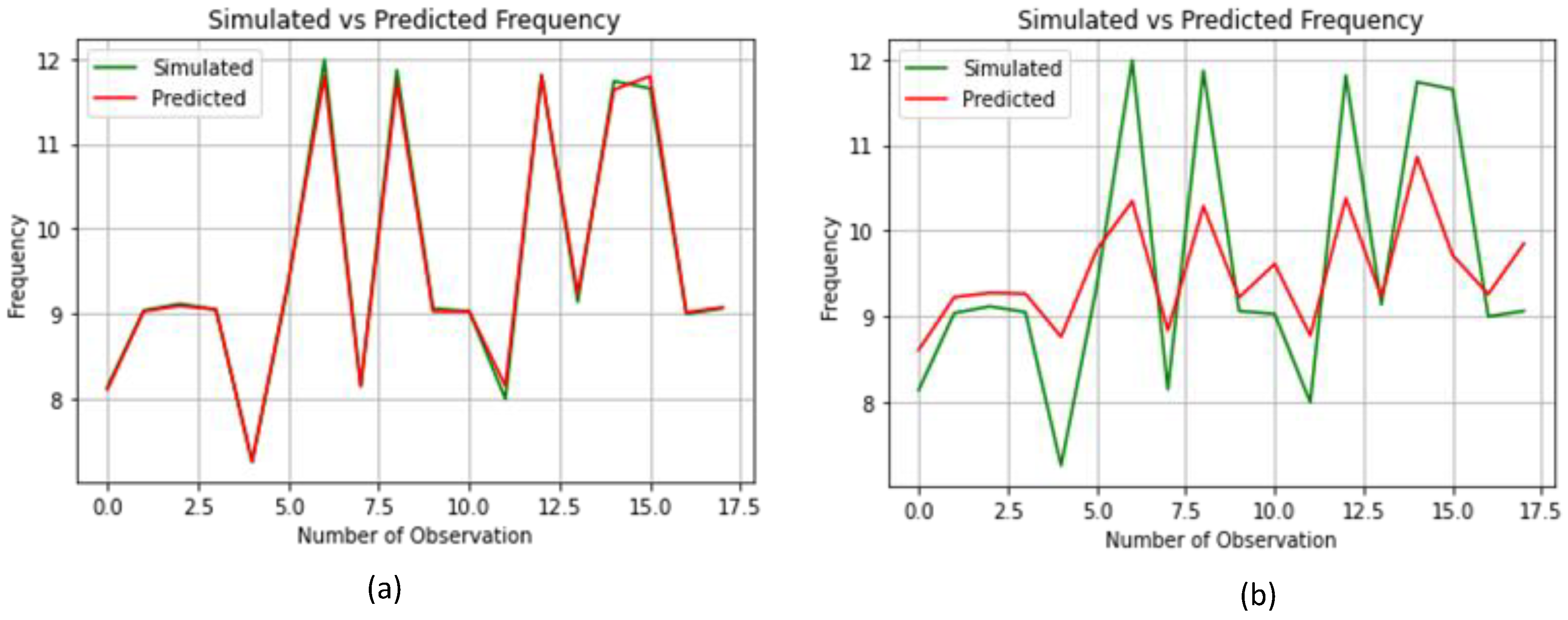
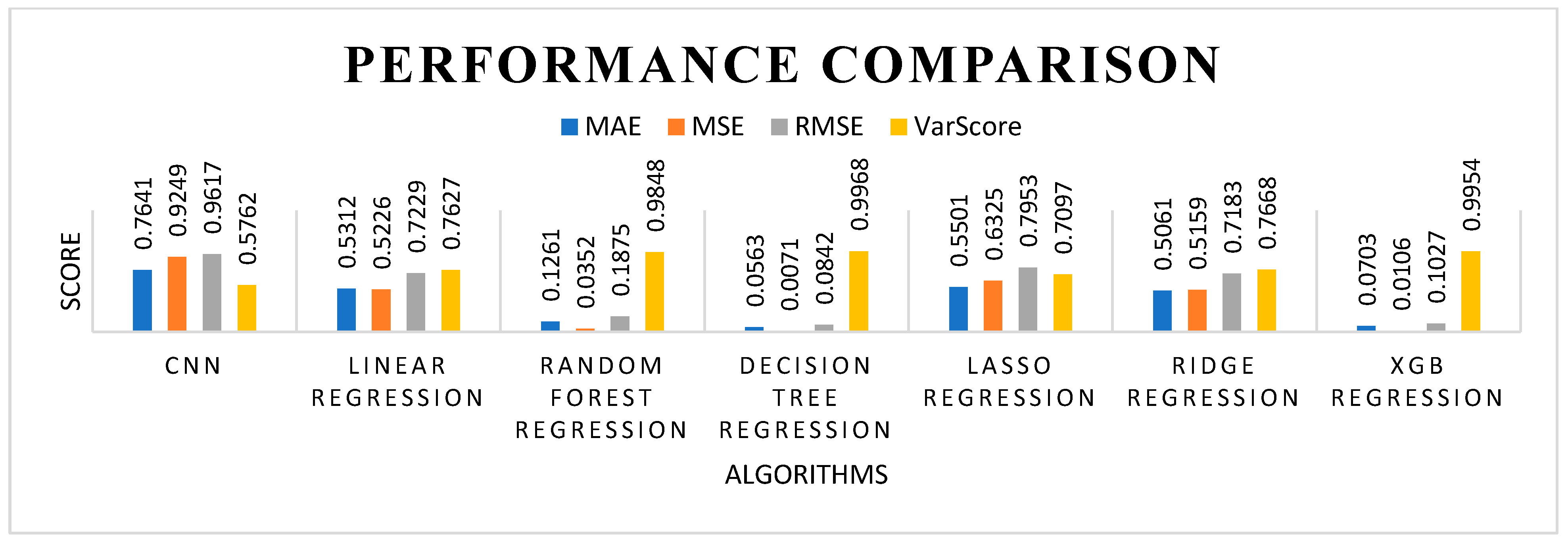
| Parameters | Full Form of Parameters | Dimensions (mm) | Parameters | Full Form of Parameters | Dimensions (mm) |
|---|---|---|---|---|---|
| Length of Substrate | 23.8 | Length of Feed Line | 10 | ||
| Length of Ground | 28.2 | Width of Feed Line | 3 | ||
| Width of Ground | 9.6 | Length of Inset | 5 | ||
| Length of Patch | 13.8 | Width of Inset | 3.6 | ||
| Width of Patch | 19 | Thickness of patch | 0.035 | ||
| Thickness of substrate | 1.6 | Thickness of Ground | 0.035 | ||
| Width of Substrate | 28.2 | - | - | - |
| Hyperparameter | Configuration |
|---|---|
| Dense layer’s activation function | ReLU |
| Batch size | 16 |
| Epoch | 100 |
| Optimization function | Adam |
| Loss | MSE |
| No. | Simulated Frequency (GHz) | Predicted Frequency (GHz) | Error Percentage (%) | No. | Simulated Frequency (GHz) | Predicted Frequency (GHz) | Error Percentage (%) |
|---|---|---|---|---|---|---|---|
| 1 | 8.1414 | 8.1113 | 0.3697 | 10 | 9.064 | 9.0285 | 0.3917 |
| 2 | 9.0396 | 9.0285 | 0.1228 | 11 | 9.0296 | 9.0296 | 0 |
| 3 | 9.1176 | 9.0953 | 0.2446 | 12 | 8 | 8.1526 | 1.9075 |
| 4 | 9.0507 | 9.0507 | 0 | 13 | 11.81 | 11.794 | 0.1355 |
| 5 | 7.2623 | 7.2623 | 0 | 14 | 9.1413 | 9.2296 | 0.9659 |
| 6 | 9.351 | 9.3841 | 0.354 | 15 | 11.734 | 11.634 | 0.8522 |
| 7 | 11.988 | 11.794 | 1.6183 | 16 | 11.649 | 11.794 | 1.2447 |
| 8 | 8.1487 | 8.1526 | 0.0479 | 17 | 9 | 9.0173 | 0.1922 |
| 9 | 11.865 | 11.712 | 1.2895 | 18 | 9.0639 | 9.0753 | 0.1258 |
| No. | Simulated Frequency (GHz) | Predicted Frequency (GHz) | Error Percentage (%) | No. | Simulated Frequency (GHz) | Predicted Frequency (GHz) | Error Percentage (%) |
|---|---|---|---|---|---|---|---|
| 1 | 8.1414 | 8.6086 | 5.73869 | 10 | 9.064 | 9.222 | 1.74353 |
| 2 | 9.0396 | 9.225 | 2.05042 | 11 | 9.0296 | 9.6116 | 6.44494 |
| 3 | 9.1176 | 9.2757 | 1.73436 | 12 | 8 | 8.7789 | 9.7363 |
| 4 | 9.0507 | 9.265 | 2.36726 | 13 | 11.81 | 10.3787 | 12.11948 |
| 5 | 7.2623 | 8.7624 | 20.65657 | 14 | 9.1413 | 9.2286 | 0.95446 |
| 6 | 9.351 | 9.7752 | 4.53594 | 15 | 11.734 | 10.8604 | 7.44519 |
| 7 | 11.988 | 10.3457 | 13.69946 | 16 | 11.649 | 9.7128 | 16.62076 |
| 8 | 8.1487 | 8.8375 | 8.45233 | 17 | 9 | 9.2611 | 2.90101 |
| 9 | 11.865 | 10.2844 | 13.32168 | 18 | 9.0639 | 9.8493 | 8.6656 |
| Algorithms | MAE | MSE | RMSE | Var Score |
|---|---|---|---|---|
| CNN | 0.7641 | 0.9249 | 0.9617 | 0.5762 |
| Linear Regression | 0.5312 | 0.5226 | 0.7229 | 0.7627 |
| Random Forest Regression | 0.1261 | 0.0352 | 0.1875 | 0.9848 |
| Decision Tree Regression | 0.0563 | 0.0071 | 0.0842 | 0.9968 |
| Lasso Regression | 0.5501 | 0.6325 | 0.7953 | 0.7097 |
| Ridge Regression | 0.5061 | 0.5159 | 0.7183 | 0.7668 |
| XGB Regression | 0.0703 | 0.0106 | 0.1027 | 0.9954 |
Publisher’s Note: MDPI stays neutral with regard to jurisdictional claims in published maps and institutional affiliations. |
© 2022 by the authors. Licensee MDPI, Basel, Switzerland. This article is an open access article distributed under the terms and conditions of the Creative Commons Attribution (CC BY) license (https://creativecommons.org/licenses/by/4.0/).
Share and Cite
Haque, M.A.; Sarker, N.; Sawaran Singh, N.S.; Rahman, M.A.; Hasan, M.N.; Islam, M.; Zakariya, M.A.; Paul, L.C.; Sharker, A.H.; Abro, G.E.M.; et al. Dual Band Antenna Design and Prediction of Resonance Frequency Using Machine Learning Approaches. Appl. Sci. 2022, 12, 10505. https://doi.org/10.3390/app122010505
Haque MA, Sarker N, Sawaran Singh NS, Rahman MA, Hasan MN, Islam M, Zakariya MA, Paul LC, Sharker AH, Abro GEM, et al. Dual Band Antenna Design and Prediction of Resonance Frequency Using Machine Learning Approaches. Applied Sciences. 2022; 12(20):10505. https://doi.org/10.3390/app122010505
Chicago/Turabian StyleHaque, Md. Ashraful, Nayan Sarker, Narinderjit Singh Sawaran Singh, Md Afzalur Rahman, Md. Nahid Hasan, Mirajul Islam, Mohd Azman Zakariya, Liton Chandra Paul, Adiba Haque Sharker, Ghulam E. Mustafa Abro, and et al. 2022. "Dual Band Antenna Design and Prediction of Resonance Frequency Using Machine Learning Approaches" Applied Sciences 12, no. 20: 10505. https://doi.org/10.3390/app122010505
APA StyleHaque, M. A., Sarker, N., Sawaran Singh, N. S., Rahman, M. A., Hasan, M. N., Islam, M., Zakariya, M. A., Paul, L. C., Sharker, A. H., Abro, G. E. M., Hannan, M., & Pk, R. (2022). Dual Band Antenna Design and Prediction of Resonance Frequency Using Machine Learning Approaches. Applied Sciences, 12(20), 10505. https://doi.org/10.3390/app122010505








